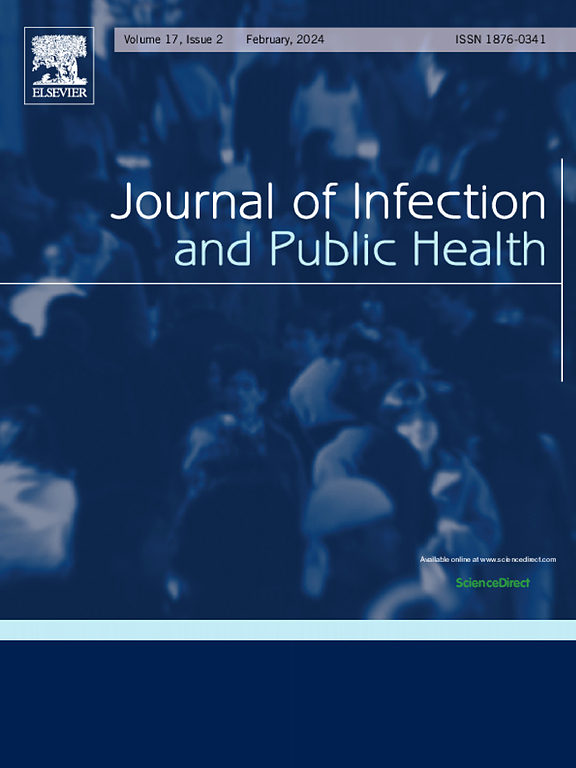Encephalitis-predominant Nipah virus outbreaks in Kerala, India during 2024
IF 4.7
3区 医学
Q1 INFECTIOUS DISEASES
引用次数: 0
Abstract
Nipah virus (NiV) is a highly pathogenic zoonotic paramyxovirus with significant public health concern. Since 2018, Kerala, India, has experienced NiV outbreaks with variable clinical manifestations ranging from acute encephalitis syndrome (AES) to acute respiratory distress syndrome (ARDS). Recently, we observed two NiV outbreaks in Malappuram, Kerala, India during 2024, with AES as the predominant clinical manifestation in July and September 2024. Among all close contacts screened no secondary transmission of NiV was observed. The data from NiV outbreaks of Kerala state indicated that AES-predominant outbreaks (2019, 2021, and 2024) had shown no human-to-human transmission compared to ARDS-predominant outbreaks (2001, 2007, 2018, and 2023). Early detection, efficient containment, and improved surveillance were important measures in preventing secondary transmission. The two spill over events of NiV in 2024 reiterates the need for enhancing the surveillance of NiV among ARDS cases for timely case management and containment of the outbreak. In view of this, a network of seventeen Virus Research and Diagnostic Laboratories (VRDLs) was established for surveillance of severe acute respiratory illnesses in West Bengal and Kerala states of India. The continued public health preparedness and community awareness would help to prevent future outbreaks.
2024年印度喀拉拉邦以脑炎为主的尼帕病毒暴发
尼帕病毒是一种高致病性人畜共患副粘病毒,具有重大公共卫生问题。自2018年以来,印度喀拉拉邦爆发了NiV疫情,其临床表现从急性脑炎综合征(AES)到急性呼吸窘迫综合征(ARDS)不等。最近,我们在2024年在印度喀拉拉邦的Malappuram发现了两起NiV疫情,2024年7月和9月以AES为主要临床表现。在筛查的所有密切接触者中,未观察到NiV的继发性传播。喀拉拉邦NiV暴发的数据表明,与ards为主暴发(2001年、2007年、2018年和2023年)相比,以aes为主的暴发(2019年、2021年和2024年)未出现人际传播。早期发现、有效遏制和改进监测是预防二次传播的重要措施。2024年发生的两次NiV外溢事件再次表明,有必要加强对ARDS病例中NiV的监测,以便及时进行病例管理和控制疫情。有鉴于此,在印度西孟加拉邦和喀拉拉邦建立了一个由17个病毒研究和诊断实验室(VRDLs)组成的网络,以监测严重急性呼吸道疾病。继续做好公共卫生准备和提高社区认识将有助于预防今后的疫情爆发。
本文章由计算机程序翻译,如有差异,请以英文原文为准。
求助全文
约1分钟内获得全文
求助全文
来源期刊

Journal of Infection and Public Health
PUBLIC, ENVIRONMENTAL & OCCUPATIONAL HEALTH -INFECTIOUS DISEASES
CiteScore
13.10
自引率
1.50%
发文量
203
审稿时长
96 days
期刊介绍:
The Journal of Infection and Public Health, first official journal of the Saudi Arabian Ministry of National Guard Health Affairs, King Saud Bin Abdulaziz University for Health Sciences and the Saudi Association for Public Health, aims to be the foremost scientific, peer-reviewed journal encompassing infection prevention and control, microbiology, infectious diseases, public health and the application of healthcare epidemiology to the evaluation of health outcomes. The point of view of the journal is that infection and public health are closely intertwined and that advances in one area will have positive consequences on the other.
The journal will be useful to all health professionals who are partners in the management of patients with communicable diseases, keeping them up to date. The journal is proud to have an international and diverse editorial board that will assist and facilitate the publication of articles that reflect a global view on infection control and public health, as well as emphasizing our focus on supporting the needs of public health practitioners.
It is our aim to improve healthcare by reducing risk of infection and related adverse outcomes by critical review, selection, and dissemination of new and relevant information in the field of infection control, public health and infectious diseases in all healthcare settings and the community.
 求助内容:
求助内容: 应助结果提醒方式:
应助结果提醒方式:


